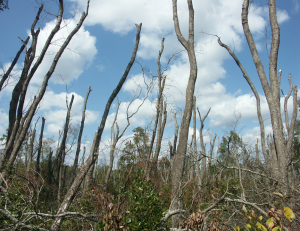Investigating species invasion patterns and processes across broad spatial scales

The exotic insect-disease complex of laurel wilt disease and redbay ambrosia beetle has killed hundreds of millions of redbay trees in coastal areas of the Southeast, including Evans County, Georgia.
SUMMARY: Biological invasions pose a major threat to forest ecosystems globally and cause significant ecosystem degradation and economic loss. Research has revealed variation in regional invasion patterns, indicating that the factors affecting invasion dynamics vary across scales and among taxonomic groups. Many small-scale studies have focused on invasion processes and impacts, while only a few have encompassed broader regions. Our understanding about the factors influencing broad-scale invasion patterns is therefore limited. More research needs to include multiple taxonomic groups, to account for the interactions among the three invasion components (invader, recipient system, and environmental drivers), and to consider the spatial and temporal scales of invasion patterns and processes.
I am a member of a multi-institutional team addressing these research needs. The group, including ecologists from Purdue University and the USDA Forest Service, has received two National Science Foundation macrosystem biology grants in recent years. I am a co-principal investigator of the more recent of these, a $1 million grant funding a project called Modeling Invasive Dynamics Across Scales (MIDAS). This group is remarkably productive, having produced about 20 peer-reviewed journal articles since 2015; I am an author on 14 of these. The most recent paper, published in the Proceedings of the National Academy of Sciences in 2019, revealed a positive relationship between tree diversity and nonnative insect and disease pests at low levels of tree diversity in U.S. forests, but a negative relationship between tree diversity and nonnative pest diversity at higher levels of tree diversity.
My primary area of expertise on the team is the appropriate use and calculation of biodiversity metrics, including those that incorporate evolutionary relationships among organisms, in the assessment of biotic resistance of native tree communities to invasive species. I additionally help formulate hypotheses to test, provide and analyze data, and assist in the writing and editing of manuscripts. Our work has received international attention both in the invasive ecology community and in the media.
LINKS:
- “How Tree Diversity Regulates Invading Forest Pests“
- “What FIA Data Tell Us about Non-native Pests of America’s Forests“
- “Do Roads Drive Forest Plant Invasions“
- “Genetic Studies Reveal a Tree’s History to Ensure its Future“
- “Plant Invasion Patterns at Global and Regional Scales“
- “Native Trees Naturally Fight Invasives in Some Eastern Forests“
- “Plant Invasions across the United States: Patterns and Clues“
- “A Big-Picture View of the Invasive Plant Problem“
CONTACT: Kevin Potter, NCSU Department of Forestry and Environmental Resources, kpotter@ncsu.edu or (919) 549-4071



